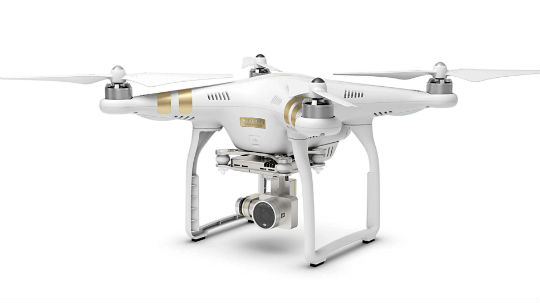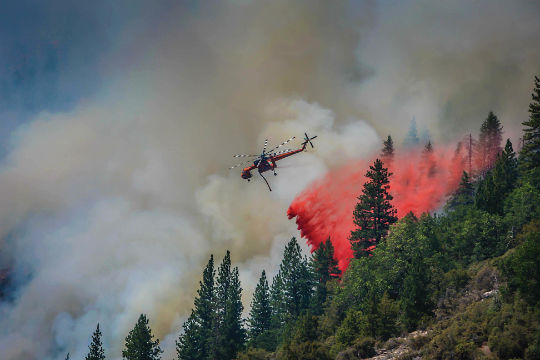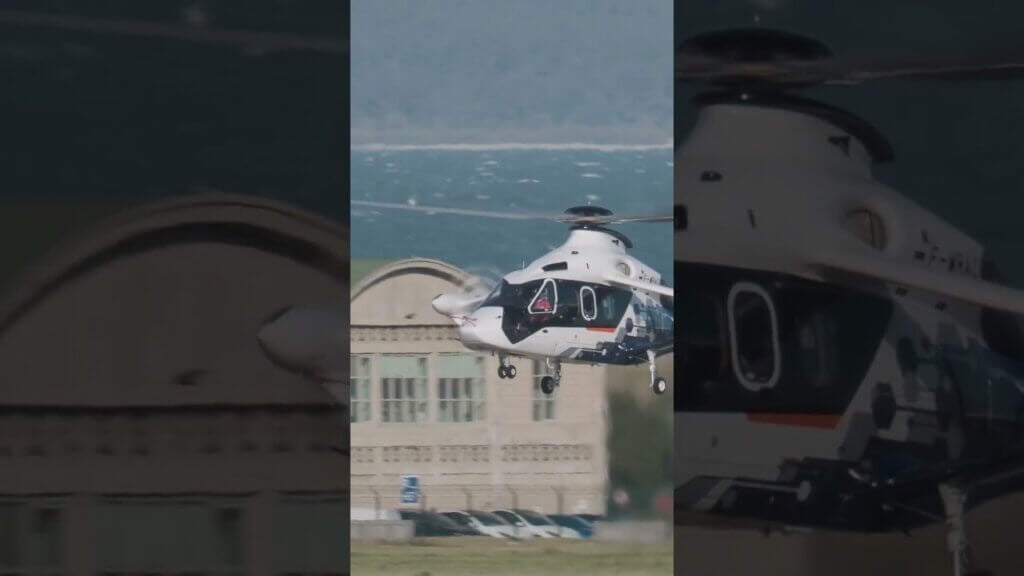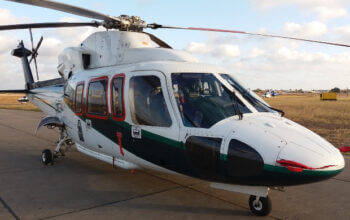
According to the Consumer Electronics Association, 700,000 consumer drones are expected to be sold in the United States this year, compared with 400,000 last year.
While flying on the Pasquale Fire in September 2014, east of Nevada City, Calif., forestry fire pilot Jason Thrasher experienced a very close call. Despite his training, experience and strong safety mindset as a California Department of Forestry and Fire Protection (CAL FIRE) pilot, he wasn’t prepared for what almost hit his Bell UH-1H Super Huey.
“There were two tankers and a yellow helo on the fire when I was called in to assist,” Thrasher explained. “I did a circuit of the fire area for recon. As I was on my base turn to final to the LZ, about 300 feet and 60 knots, I saw what I thought was another helo in the distance. In the time it took me to realize it wasn’t yellow, and the split second to process my error in depth perception, I realized it was a drone and it was only 10 feet away.” For comparison, a Huey’s rotor diameter is 48 feet.
Thrasher did a hard left bank and the drone flew by. As he continued his left turn to track the craft, he noted it was a small, black quad-rotor drone typically used by hobbyists, and it was flying away from the fire.
When Thrasher returned to base, he filed a CAL FIRE incident report.
Incident reporting spike
According to the Consumer Electronics Association, 700,000 consumer drones are expected to be sold in the United States this year, compared with 400,000 last year. With more than a million drones flying in airspace regulated by the Federal Aviation Administration (FAA), an increase in sightings is arguably inevitable.
Thrasher’s incident report is one of hundreds in the past two years, according to the FAA. Last August, the FAA announced pilot reports of close calls in 2015 were on a sharp rise.
The 238 sightings reported in 2014 contrasts with 650 by Aug. 9 of 2015 (although groups including the Academy of Model Aeronautics [AMA] have pointed out that only a relatively small fraction of those sightings represent near-misses). This announcement came on the heels of several highly publicized aircraft groundings during organized wildland fire battles in the United States, caused by the presence of unmanned aerial vehicles (UAVs) in the area.

An Erickson S-64 deploys retardant to prevent the spread of a wildfire. Firefighting operations have had to be briefly suspended in Canada and the United States this year due to the presence of UAVs in the vicinity. Andrew Luke Photo
The story is much the same in Canada. Transport Canada issued a Civil Aviation Safety Alert in August this year to report a sharp rise in model aircraft and UAVs in the vicinity of British Columbia wildfires, causing interruption in aerial firefighting. The report reminded UAV operators that their aircraft must remain five miles from fires.
The FAA and Transport Canada announcements are part of a larger organized effort to increase awareness about UAVs, their operating rules, and the dangers they pose to manned aircraft as well as people on the ground.
“I believe the root of this issue is caused the hobbyist drone operators, who for the most part don’t know or understand aviation rules,” said Jim Williams, principal at technology law firm Dentons and former manager of the FAA’s Unmanned Aircraft Systems (UAS) office. “Sure, there are a few bad apples, but I really feel the majority just aren’t aware of the rules and that is where we need to work to increase awareness and education. A collision with an unmanned aircraft could be catastrophic to manned aircraft, especially helicopters.”
Safety Concerns
The average weight of a small recreational UAV is between three and five pounds, with some commercial UAVs carrying cameras and sensors weighing in closer to 15 lbs. or more.
In contrast, a wild duck weighs about 3.5 lbs., and a Canada Goose can weigh between seven and 14 lbs. Both birds have caused significant and catastrophic damage to helicopters, and even commercial airliners when ingested into an engine.
“A drone alone is hard to see, but a black drone with no lights or markings against a busy background is impossible to see until it’s in the cockpit with you,” said Rex Alexander, senior consultant with HeliExperts and former emergency medical services (EMS) pilot and president of the National EMS Pilots Association (NEMSPA). “And birds are pliable.
What could a plastic and metal drone with a very volatile lithium polymer battery, that is illegal to put in the cargo hold of a commercial airliner, by the way, going to do to a helicopter? In EMS, where we operate away from airports, landing in places where there may be drones flying around getting pictures of an accident, and at the speeds we fly to get patients to the hospital, there is a real risk of a catastrophic drone encounter to us.”
FAA regulations are very relaxed for recreational drones, in part because of heavy lobbying efforts of organizations such as the AMA to protect their members’ rights, Williams said. Commercial operations are more regulated. However, technology to track drones, such as TCAS, is still too heavy to add to the vehicles, so this technology is also not required.
The Regulatory Picture
Currently, it is illegal to fly a commercial UAV in the U.S. without an exemption from the FAA. Whether taking photos for a realtor, teaching someone who paid to attend a class to fly a UAS, filming a scene for the next Michael Bay blockbuster, or gathering readings for mineral exploration, you must apply for a Section 333 exemption.
The name of the exemption stems from its place in the FAA Modernization and Reform Act of 2012 that allows the secretary of transportation to determine if an airworthiness certificate is required for a UAS. As of publication date, the FAA had granted more than 1,350 of these exemptions, with an average of 80 being approved a week, a mere fraction of the overall number of drones flying in the country today.
Today, operators granted the exemption must register their aircraft, apply N-number stickers to the UAV, be a current FAA-licensed pilot (sport pilot or higher in any aircraft type with a biannual flight review in the past 24 months), and follow specific rules outlined for drone operations — mainly to operate below 400 feet, not to fly in populated areas or over people other than the operators of the UAV, and to stay five miles from an airport or heliport (unless permission is received to enter that airspace).
However, earlier this year, the FAA issued a draft notice of proposed rulemaking governing commercial UAV operations, which is expected to be finalized within the year. In this proposed rule, the requirement for a pilot’s license is removed. Instead, operators (who must be at least 17) will be required to pass an aviation knowledge test every 24 months to remain certified to fly UAVs. Among the requirements in the new rule, the UAV will be limited to 500 feet and 100 m.p.h, must remain in sight of the operator, must be under 55 lbs., and operated during daylight hours. The full list of requirements can be found on the FAA’s website (faa.gov).
Model UAVs, however, are a completely different story. The commercial rules, both current and proposed, are only a recommendation to those operating their UAV aircraft for hobby or recreation. The commercial guidelines are a suggestion, and the FAA also suggests operators of these vehicles, who require no aviation or operator training, join a model aircraft club and follow both the club’s operating rules as well as those of a national organization such as the AMA. The only enforcement the FAA can take against these operators is under Federal Aviation Regulation 91.13: careless and reckless operation.
Education is Key
Matt Mushak is the founder of the Northern Ohio Unmanned Aircraft Systems Association (NOUASA), an organization created to promote safe and non-intrusive use of UAVs in the region to commercial and recreational users of the aircraft. One of the many things NOUASA does is provide free education.
“Drone operators today are not coming up through the former traditional ranks of radio controlled groups,” Mushak said. “Before these easy-to-operate drones, there were complicated and expensive R/C helicopters and airplanes. People joined R/C clubs to learn how to properly operate them. Drones today are so easy to fly, with all the onboard stability and navigation; the need to learn from a knowledgeable community isn’t there. You can just turn it on and take off. At NOUASA, we’re looking for those people and trying to educate them.”
Mushak’s group reaches out to hobby stores and into photography circles to invite operators to join the organization and attend free seminars. Their vastly popular “Drone for the Holidays” class, offered in January, included EMS pilots from the Metro Heath Medical Center who talked about dangers of drones to aircraft, particularly helicopters.
The group also filmed a carefully controlled situation where a drone flew close to a small plane, with cameras onboard the airplane, illustrating for attendees how near impossible drones are to see from a manned aircraft.
“We find most people want to do the right thing, but they have no idea what that is,” Mushak said. “For instance, many drones have a ‘home’ safety built in. If the operator becomes uncertain or needs the drone to come back, push the ‘home’ button and it flies back to the operator — if it was calibrated as it should have been before the flight. Unfortunately, some operators skip that step and when ‘home’ is pushed, the drone flies off toward Hong Kong or wherever else it was last calibrated. We believe that is the cause of many of these ‘runaway drone’ reports.”
Currently, two large national campaigns, supported by public and private groups, are focused on spreading the word about safe drone operations, “Know Before You Fly” and “If You Fly, We Can’t.”
The “Know Before You Fly” education campaign, founded by the Association for Unmanned Vehicle Systems International (AUVSI), the AMA, and the Small UAV Coalition in partnership with the Federal Aviation Administration, serves to educate prospective users about the safe and responsible operation of unmanned aircraft systems. Their website (knowbeforeyoufly.org) provides detailed information on safe, smart and legal operating practices for hobby and commercial users. These groups are also working to get information included in UAV packaging as an added step said Tom McMahon, vice president of public affairs of the AUVSI.
The “If You Fly, We Can’t” campaign is supported by multiple agencies fighting forest fires across the U.S., including the U.S. Forest Service and more local level agencies such as CAL FIRE. Taking a more direct approach, this campaign illustrates what is happening at fires across the nation. If a drone is sighted, aerial firefighting efforts are suspended.
Simply put, the UAVs risk the lives of firefighters by flying into the temporary flight restriction (TFR) placed around the fire. When the aircraft leave as a result, risk to property and life increase with no aerial fire suppression to limit the fire. The campaign includes red signs posted throughout the fire area as well as reminders to media covering the fire, and website and social media posts by the agencies updating locals about the blaze.
“Educating and enforcing safety for people on the ground and pilots in the air is going to have to be the priority and a shared effort between federal, state and local governments, as well as these UAS operating groups,” Williams said. “The FAA owns the airspace, but the cities, airport authorities, counties and states control the land. My position is everyone needs to take a more proactive approach, from government to the media, to help educate.”









